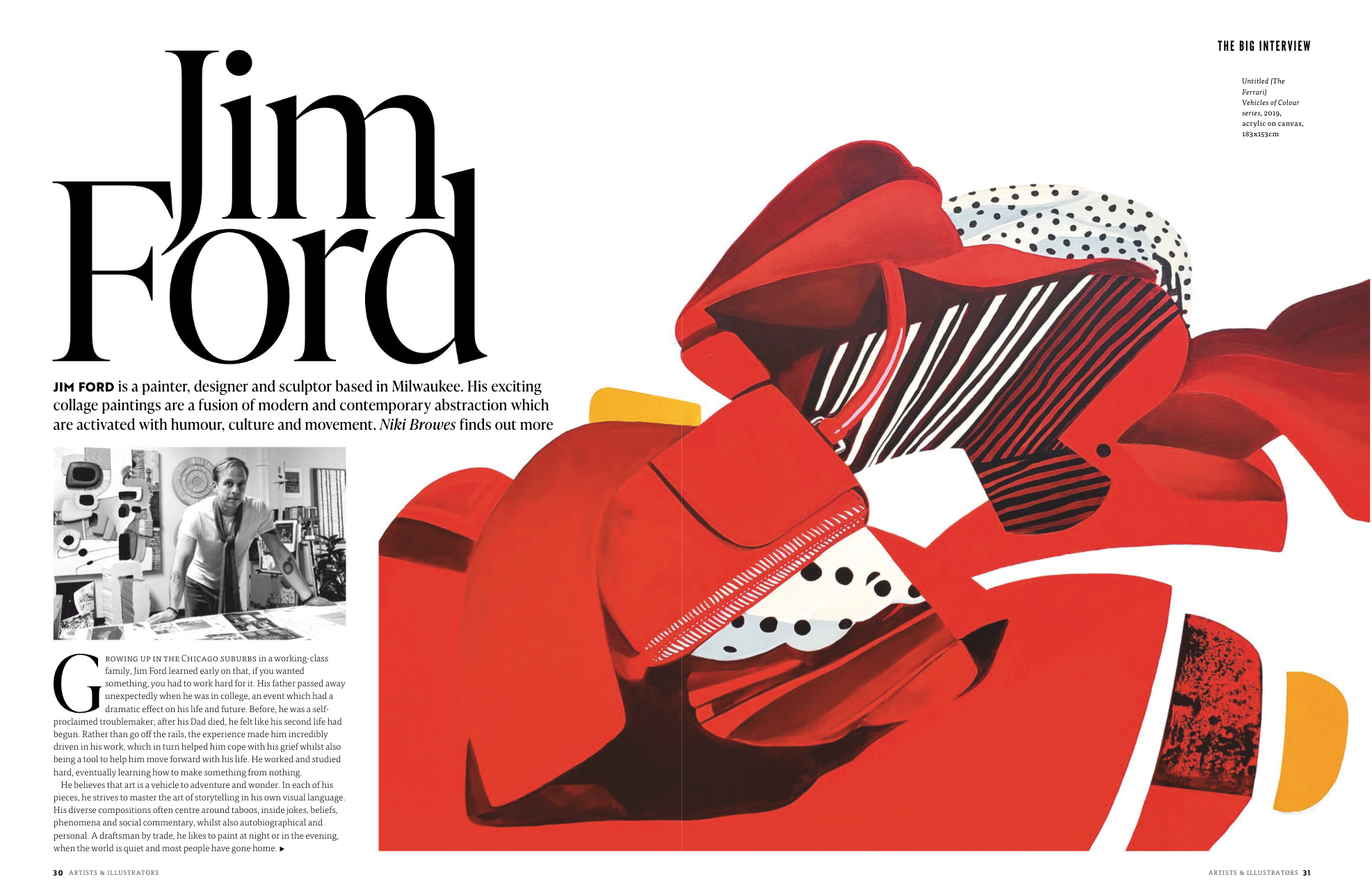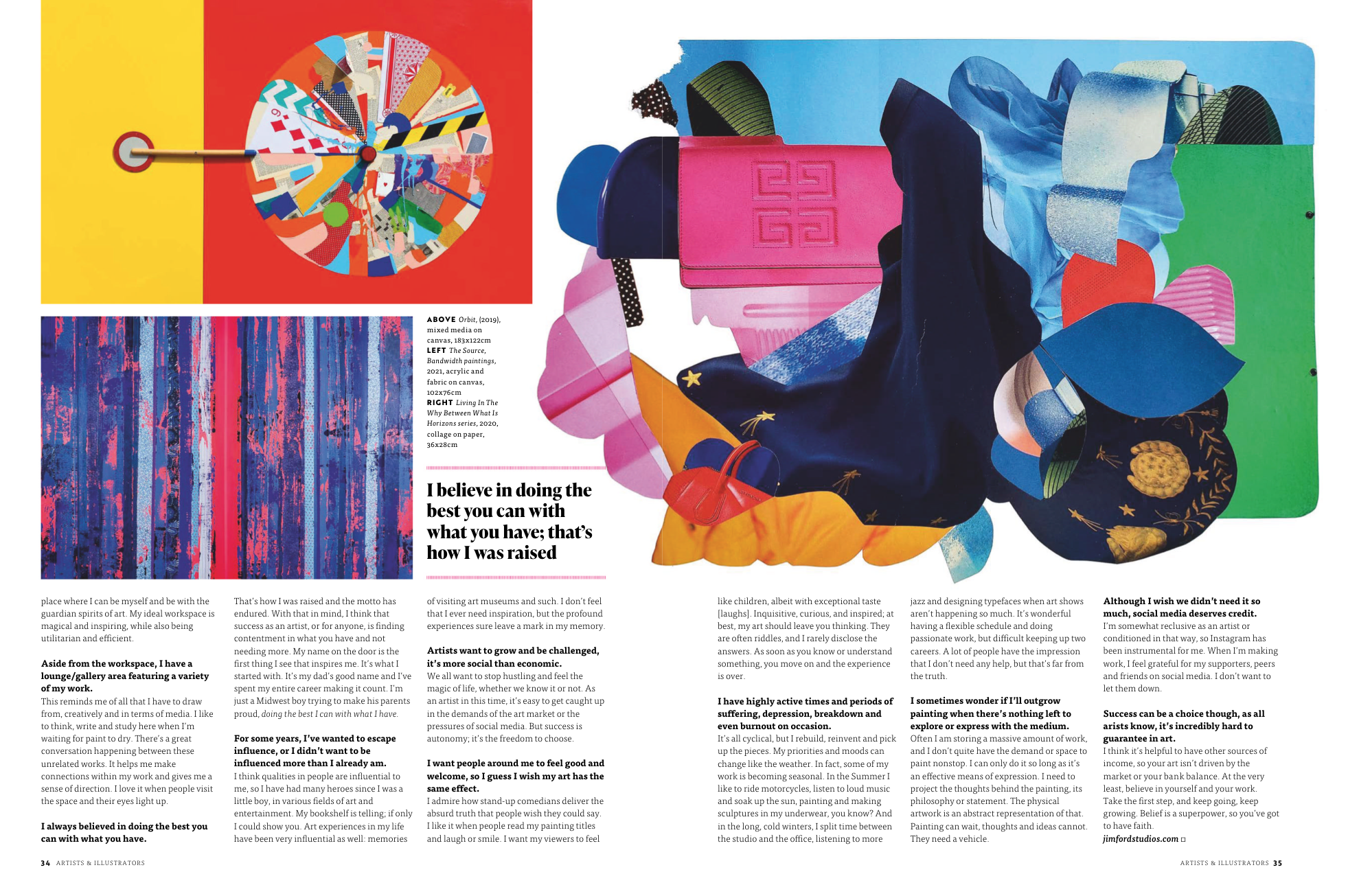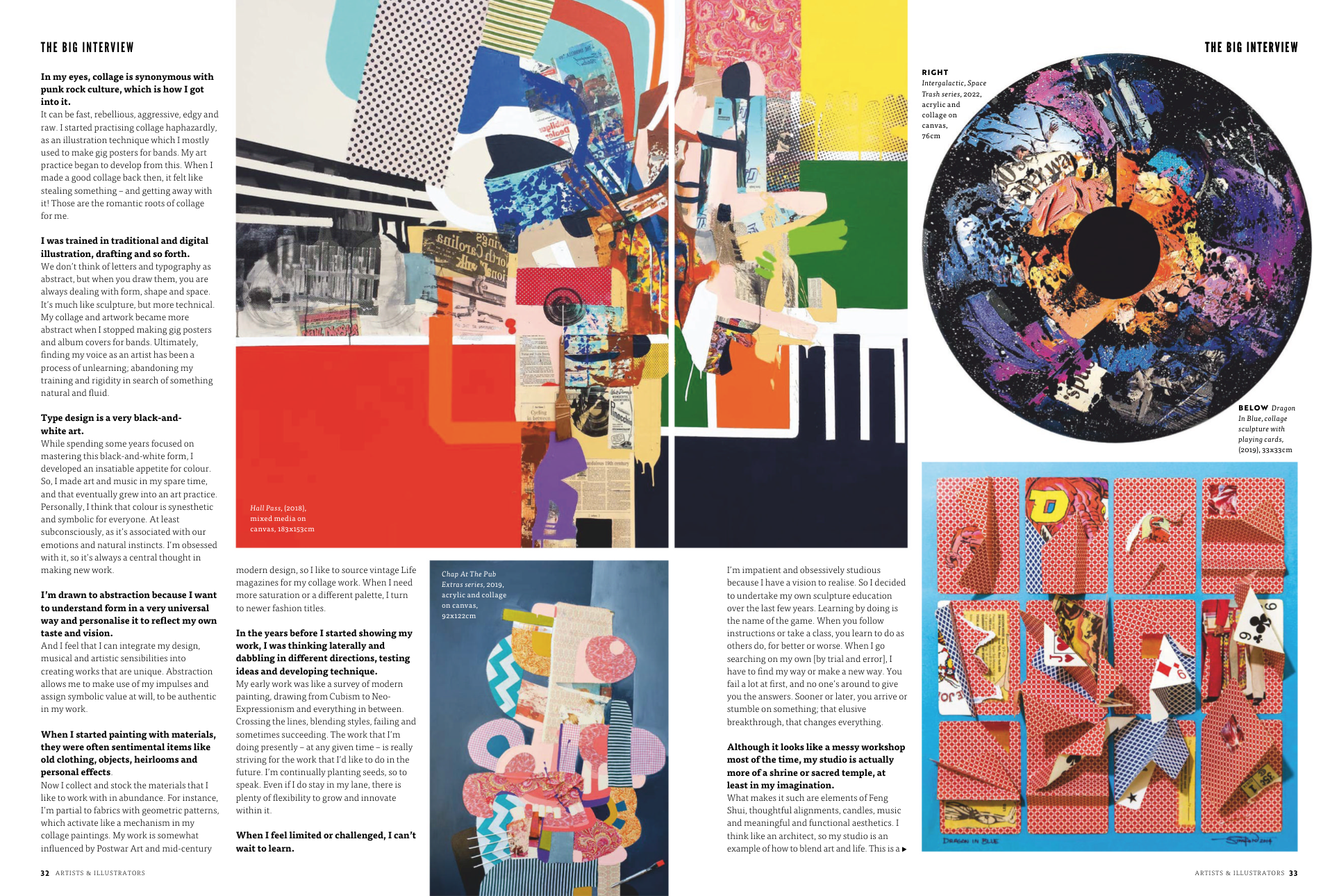The Big Interview
Artists & Illustrators, January 2023
JIM FORD is a painter, designer and sculptor based in Milwaukee. His exciting collage paintings are a fusion of modern and contemporary abstraction which are activated with humour, culture and movement. Niki Browes finds out more ▸
Growing up in the Chicago suburbs in a working-class family, Jim Ford learned early on that, if you wanted something, you had to work hard for it. His father passed away unexpectedly when he was in college, an event which had a dramatic effect on his life and future. Before, he was a self-proclaimed troublemaker; after his Dad died, he felt like his second life had begun. Rather than go off the rails, the experience made him incredibly driven in his work, which in turn helped him cope with his grief whilst also being a tool to help him move forward with his life. He worked and studied hard, eventually learning how to make something from nothing. He believes that art is a vehicle to adventure and wonder. In each of his pieces, he strives to master the art of storytelling in his own visual language. His diverse compositions often centre around taboos, inside jokes, beliefs, phenomena and social commentary, whilst also autobiographical and personal. A draftsman by trade, he likes to paint at night or in the evening, when the world is quiet and most people have gone home. ▸
In my eyes, collage is synonymous with punk rock culture, which is how I got into it. It can be fast, rebellious, aggressive, edgy and raw. I started practising collage haphazardly, as an illustration technique which I mostly used to make gig posters for bands. My art practice began to develop from this. When I made a good collage back then, it felt like stealing something – and getting away with it! Those are the romantic roots of collage for me.
I was trained in traditional and digital illustration, drafting and so forth. We don’t think of letters and typography as abstract, but when you draw them, you are always dealing with form, shape and space. It’s much like sculpture, but more technical. My collage and artwork became more abstract when I stopped making gig posters and album covers for bands. Ultimately, finding my voice as an artist has been a process of unlearning; abandoning my training and rigidity in search of something natural and fluid.
Type design is a very black and white art. While spending some years focused on mastering this black-and-white form, I developed an insatiable appetite for colour. So, I made art and music in my spare time, and that eventually grew into an art practice. Personally, I think that colour is synesthetic and symbolic for everyone. At least subconsciously, as it’s associated with our emotions and natural instincts. I’m obsessed with it, so it’s always a central thought in making new work.
I’m drawn to abstraction because I want to understand form in a very universal way and personalise it to reflect my own taste and vision. And I feel that I can integrate my design, musical and artistic sensibilities into creating works that are unique. Abstraction allows me to make use of my impulses and assign symbolic value at will, to be authentic in my work.
When I started painting with materials, they were often sentimental items like old clothing, objects, heirlooms and personal effects. Now I collect and stock the materials that I like to work with in abundance. For instance, I’m partial to fabrics with geometric patterns, which activate like a mechanism in my collage paintings. My work is somewhat influenced by Postwar Art and mid-century modern design, so I like to source vintage Life magazines for my collage work. When I need more saturation or a different palette, I turn to newer fashion titles.
In the years before I started showing my work, I was thinking laterally and dabbling in different directions, testing ideas and developing technique. My early work was like a survey of modern painting, drawing from Cubism to Neo-Expressionism and everything in between. Crossing the lines, blending styles, failing and sometimes succeeding. The work that I’m doing presently – at any given time – is really striving for the work that I’d like to do in the future. I’m continually planting seeds, so to speak. Even if I do stay in my lane, there is plenty of flexibility to grow and innovate within it.
When I feel limited or challenged, I can’t wait to learn. I’m impatient and obsessively studious because I have a vision to realise. So I decided to undertake my own sculpture education over the last few years. Learning by doing is the name of the game. When you follow instructions or take a class, you learn to do as others do, for better or worse. When I go searching on my own [by trial and error], I have to find my way or make a new way. You fail a lot at first, and no one’s around to give you the answers. Sooner or later, you arrive or stumble on something; that elusive breakthrough, that changes everything.
Although it looks like a messy workshop most of the time, my studio is actually more of a shrine or sacred temple, at least in my imagination. What makes it such are elements of Feng Shui, thoughtful alignments, candles, music and meaningful and functional aesthetics. I think like an architect, so my studio is an example of how I blend art and life. This is a place where I can be myself, in peace with God and the guardian spirits of art. My ideal workspace is magical and inspiring, while also being utilitarian and efficient.
Aside from the workspace, I have a lounge/gallery area featuring a variety of my work. This reminds me of all that I have to draw from, creatively and in terms of media. I like to think, write and study here when I’m waiting for paint to dry. There’s a great conversation happening between these unrelated works. It helps me make connections within my work and gives me a sense of direction. I love it when people visit the space and their eyes light up.
I always believed in doing the best you can with what you have. That’s how I was raised and the motto has endured. With that in mind, I think that success as an artist, or for anyone, is finding contentment in what you have and not needing more. My name on the door is the first thing I see that inspires me. It’s what I started with. It’s my dad’s good name and I’ve spent my entire career making it count. See, I’m just a Midwest boy trying to make his parents proud – doing the best I can with what I have.
For some years, I’ve wanted to escape influence, or I didn’t want to be influenced more than I already am. I think qualities in people are influential to me, so I have had many heroes since I was a little boy, in various fields of art and entertainment. My bookshelf is telling; if only I could show you. Art experiences in my life have been very influential as well: memories of visiting art museums and such. I don’t feel that I ever need inspiration, but the profound experiences sure leave a mark in my memory.
Artists want to grow and be challenged, it’s more social than economic. We all want to stop hustling and feel the magic of life, whether we know it or not. As an artist in this time, it’s easy to get caught up in the demands of the art market or the pressures of social media. But success is autonomy; it’s the freedom to choose.
I want people around me to feel good and welcome, so I guess I wish my art has the same effect. I admire how stand-up comedians deliver the absurd truth that people wish they could say. I like it when people read my painting titles and laugh or smile. I want my viewers to feel like children, with exceptional taste [laughs]. Inquisitive, curious, and inspired; at best, my art should leave you thinking. They are often riddles, and I rarely disclose the answers. As soon as you know or understand something, you move on and the experience is over.
I have highly active times and periods of suffering, depression, breakdown and even burnout on occasion. It’s all cyclical, but I rebuild, reinvent and pick up the pieces. My priorities and moods can change like the weather. In fact, some of my work is becoming seasonal. In the Summer I like to ride motorcycles, listen to loud music and soak up the sun, painting and making sculptures in my underwear, you know? And in the long, cold winters, I split time between the studio and the office, listening to more jazz and designing typefaces when art shows aren’t happening so much. It’s wonderful having a flexible schedule and doing passionate work, but difficult keeping up two careers. A lot of people have the impression that I don’t need any help, but that’s far from the truth.
I sometimes wonder if I’ll outgrow painting when there’s nothing left to explore or express with the medium. Often I am storing a massive amount of work, and I don’t quite have the demand or space to paint nonstop. I can only do it so long as it’s an effective means of expression. I need to project the thoughts behind the painting, its philosophy or statement. The physical artwork is an abstract representation of that. Painting can wait, thoughts and ideas cannot. They need a vehicle.
Although I wish we didn’t need it so much, social media deserves credit. I’m somewhat reclusive as an artist or conditioned in that way, so Instagram has been instrumental for me. When I’m making work, I feel grateful for my supporters, peers and friends on social media. I don’t want to let them down.
Success can be a choice, though as all artists know, it’s incredibly hard to guarantee in art. I think it’s helpful to have other sources of income, so your art isn’t driven by the market or your bank balance. At the very least, believe in yourself and your work. Take the first step, and keep going, keep growing. Belief is a superpower, so you’ve got to have faith.
artistsandillustrators.co.uk ·



